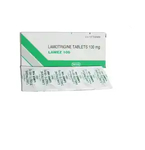lamgee
Introduction to lamgee
Lamgee, also known as Lamotrigine, is a medication primarily used to treat epilepsy and bipolar disorder. It helps in controlling seizures and stabilizing mood swings, making it a vital part of treatment for these conditions.
Composition of lamgee
Lamgee contains the active ingredient Lamotrigine, which works by stabilizing electrical activity in the brain. It inhibits certain voltage-gated sodium channels, reducing the release of excitatory neurotransmitters like glutamate.
Uses of lamgee
- Control of partial seizures in epilepsy
- Management of generalized tonic-clonic seizures
- Prevention of depressive episodes in bipolar disorder
- Stabilization of mood swings
- Off-label use for conditions like borderline personality disorder
- Adjunct treatment for neuropathic pain
Side effects of lamgee
Common side effects:
- Dizziness
- Headache
- Nausea
- Insomnia
Serious side effects:
- Severe skin rash, potentially leading to life-threatening conditions like Stevens-Johnson syndrome
- Liver problems
- Blood disorders
- Increased risk of suicidal thoughts or behavior
Precautions of lamgee
Lamgee should be used with caution in individuals with liver or kidney problems. Gradual dose adjustments are necessary to reduce the risk of severe skin reactions. If a rash develops, the medication should be discontinued immediately. It's also important to monitor for signs of suicidal thoughts.
How to Take lamgee
- Start with a low dose, typically 25 mg once daily for the first 2 weeks
- Gradually increase the dose to 50 mg, then 100 mg, and up to 200 mg per day as needed
- Take with or without food
- Swallow tablets whole with water
Conclusion of lamgee
Lamgee is an effective medication for managing epilepsy and bipolar disorder. By stabilizing electrical activity in the brain, it helps control seizures and mood swings. However, it is important to follow dosage instructions carefully and be aware of potential side effects. Always consult with a healthcare provider for personalized advice and monitoring.
Similar Medicines
Available in 2 variations

Lamgee DT 100 Tablet
Lamgee DT 100 Tablet
strip of 10 tablet dt

Lamgee DT 50 Tablet
Lamgee DT 50 Tablet
strip of 10 tablet dt
Related Faqs

I started Lamictal and developed a rash. The doctor stopped Lamictal immediately and prescribed another medicine. Why?
In some cases patients have experienced significant skin rashes and subsequently required hospitalization within just 8 weeks of initiating treatment with Lamictal These rashes can progress to severe skin infections posing a potential threat to the patients life As a precautionary measure it is strongly recommended that if a patient develops any type of rash after commencing Lamictal the medication should be discontinued immediately and not resumed This advice applies even to cases where the rashes appear to be mild or nonserious Consequently your doctor made the decision to switch your medication to ensure your safety and minimize any potential risks associated with taking Lamictal

How to take Lamictal?
Lamictal an anticonvulsant medication is suitable for consumption with or without food Adhering to the doctors recommended dosage and duration is crucial for reaping the full advantages of Lamictal Whether taken with a meal or on an empty stomach Lamictal remains effective in its intended purpose Therefore individuals can choose to ingest it with or without food depending on their personal preference or convenience It is essential however to follow the prescribed dosage and duration of the medication as advised by the healthcare professional By maintaining this regimen patients can ensure they receive the maximum benefits from using Lamictal Consequently it is vital to consult with a healthcare provider for proper instruction on how to take Lamictal and to address any concerns or questions about the medication Following the recommended guidelines will contribute to the safe and effective use of Lamictal and optimize its positive effects

How long does it take Lambi to work?
The duration of symptom improvement can vary from individual to individual but generally it may take approximately 6 to 8 weeks for your symptoms to start getting better This timeframe allows for the body to adjust and respond to the treatment or natural healing process It is important to note that the healing process is unique to each persons circumstances and condition so the rate of improvement may differ However with time and appropriate care you can expect to experience a gradual alleviation of your symptoms Patience and adherence to the recommended treatment plan are crucial during this period as it allows for the body to fully recover and regain its optimal functionality Additionally it is advisable to consult with your healthcare professional or specialist to monitor your progress and make any necessary adjustments to your treatment plan Remember the healing journey may take time but with patience and diligence you can expect to see positive changes in your condition

I started Lamizine and developed a rash. The doctor stopped Lamizine immediately and prescribed another medicine. Why?
There have been several documented cases in which patients have experienced the onset of severe rashes within a period of 8 weeks after initiating Lamizine treatment leading them to require hospitalization In some instances these rashes have escalated into lifethreatening skin infections posing a significant risk to the patients wellbeing Consequently it is strongly recommended that if a patient presents with the emergence of rashes subsequent to commencing Lamizine therapy the medication should be immediately discontinued and must not be reintroduced Even if the rashes are mild or seemingly insignificant the use of Lamizine should be halted as a precautionary measure It is due to this critical concern that your doctor has decided to switch your medication in order to prioritize your safety and wellbeing

What can be the consequences of taking a higher than the recommended dose of Lamgee?
If you happen to encounter sudden and involuntary eye movements difficulty coordinating your movements or a general lack of coordination it is likely that you are experiencing a few side effects of Lamgee In more severe cases taking higher doses of this medication may result in issues with maintaining balance irregular heart rhythms loss of consciousness seizures or even slipping into a coma It is crucial to note that seeking immediate medical assistance from a qualified doctor or the nearest hospital is imperative regardless of whether you are experiencing any obvious discomfort or not By doing so you can ensure that you receive the necessary attention and appropriate treatment to address these symptoms effectively Remember prompt medical intervention is vital for your wellbeing and peace of mind

I started Lamigine and developed a rash. The doctor stopped Lamigine immediately and prescribed another medicine. Why?
There have been cases reported in which individuals have experienced the onset of severe rashes within a span of 8 weeks after initiating treatment with Lamigine leading to their hospitalization In some instances these rashes have progressed into severe skin infections putting the patients life at risk Consequently it is strongly recommended that if a patient develops any type of rash subsequent to starting Lamigine the medication should be immediately discontinued and not resumed thereafter Even if the rashes appear mild or nonserious the use of Lamigine is halted which is precisely why your doctor made the decision to switch your medication This precautionary measure is crucial in order to safeguard your health and prevent any potential lifethreatening complications associated with these rashes
Related Posts

1:15
How Do You Know If You Have a Vaginal Infection? Warning Signs!

1:15
Top Health Benefits of Cinnamon | How to Use It for Better Health!

1:15
Is Your Blood Pressure Too Low? What Are the Best Remedies to Fix Low Blood Pressure Instantly?

1:15
Mala D: How it works, When and How to take Mala D and Side Effects of Mala D!

1:15
Reduce Inflammation Naturally: Best Foods for Heart, Diabetes & Overall Health!



















.svg)
